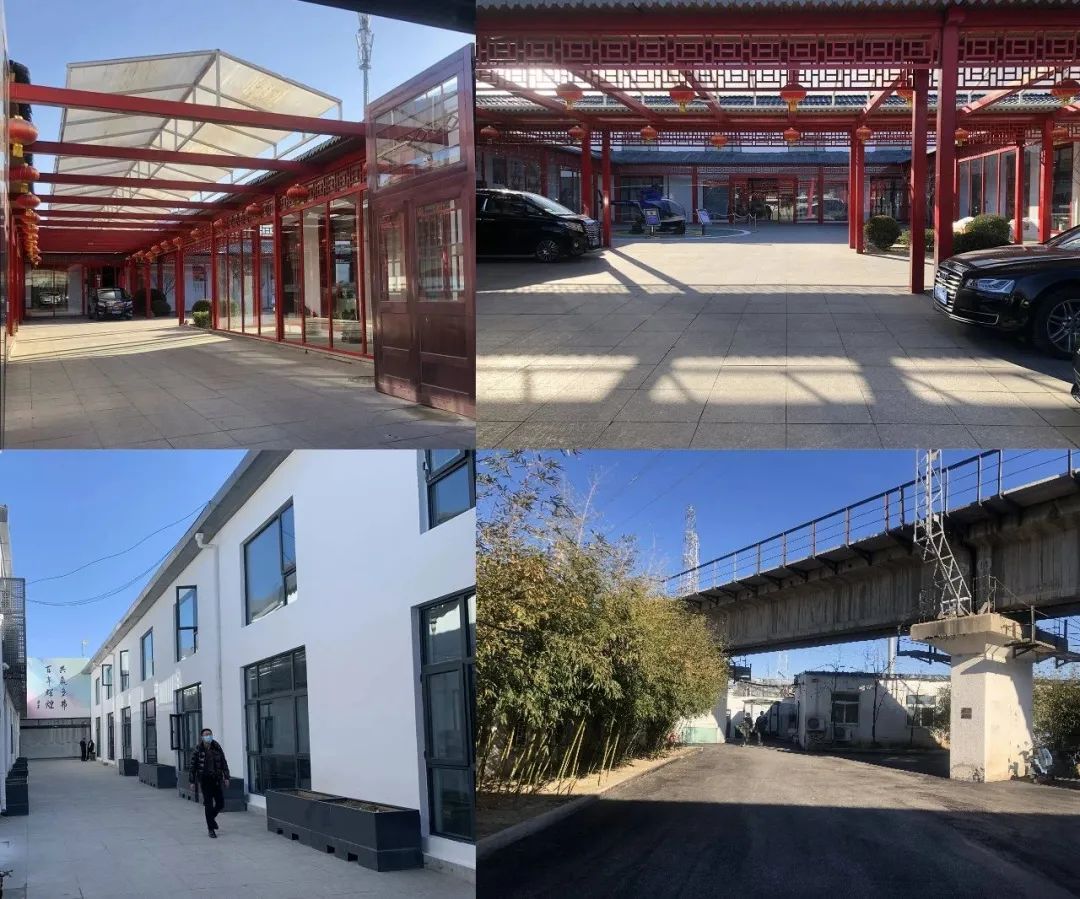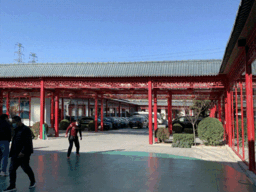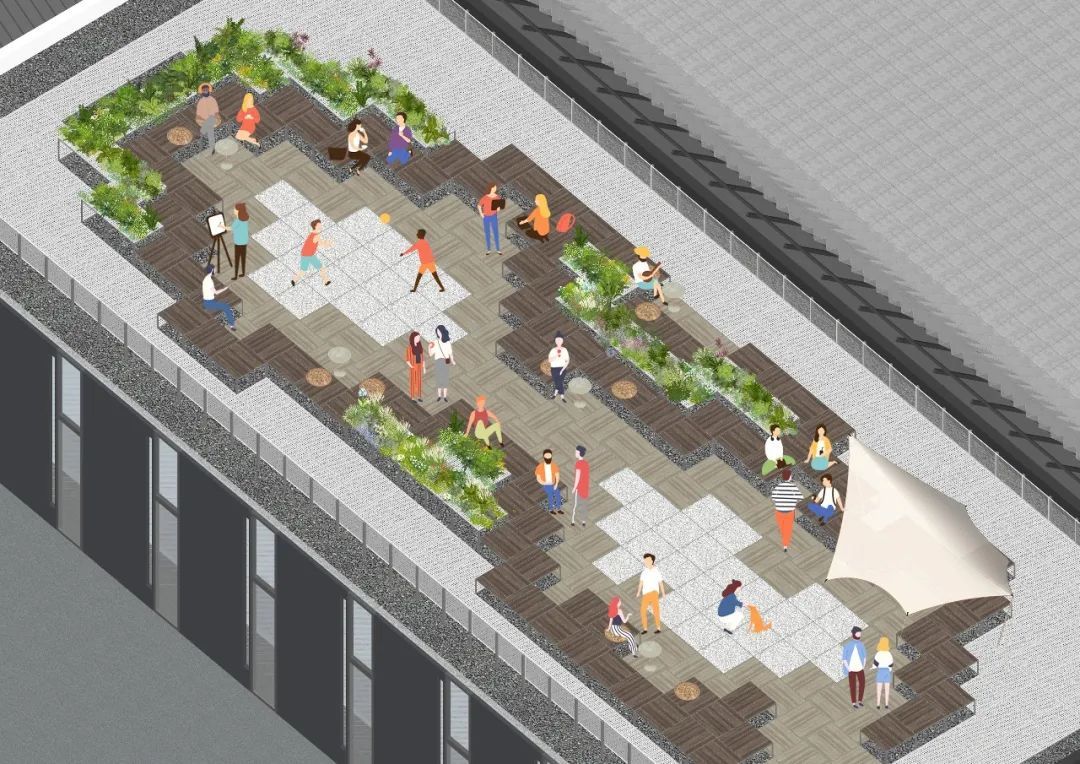Chapter 1 项目概述 / Project overview
野境建筑设计事务所于2021年底受多弗集团委托,对其在北京高碑店的办公园区进行外部空间提升的城市更新改造设计。
OEO was appointed by Duofu International Holdings Group in 2021 to carry out design work to enhance the overall appearance for its office complex in Gaobeidian, Beijing.
进入园区的通廊,view of the covered entrance passage © Vincent 冯筱童
多弗办公园区位于北京东四环与五环之间,被数条纵横交错的铁轨割据出的菱形地块一角,其周边为充满现代气息与文艺气质的“西店记忆”文创街区。多弗办公园区总占地约8000m²,为企业独立办公园区,现状空间可视为三进院落式布局,由一层或二层建筑组成;园区内部经过时期不同且需求各异的多次加建与改造,空间结构混乱、建筑形态缺乏年代感、大量非正统中式装饰构件被附着在建筑立面上,这既无法体现企业的国际化定位,也难以与周边文创街区的城市状态相融洽。
项目在面临这样一个极丰富的城市空间语境的同时,又受到严格的预算控制和紧张的工程周期限制,我们以一种微介入的方式代替单纯的大面积表面“装修”,系统地从点-线一面关键部位的更新改造切入,使整个项目建立起密切的空间关联,形成内容丰富的整体场景;在设计操作上,尽可能地避免对原有结构进行大的调整、减少不必要的形式表达、采用直白的改造策略、运用可控的材料、经过深思熟虑的设计工作,营造独特而有质量的空间体验。
The office complex is located between the east fourth and fifth ring roads of Beijing, in a diamond shaped plot surrounded by several crisscrossing overhead railway tracks. The site locates in an urban renewal area with modern and artistic cultural atmosphere. The office complex is an independent development with a site area of approximately 8000m². The current spatial organization can be seen as a three entry courtyard layout, composes of one or two storey buildings; it has undergone multiple extension and renovation works in time, that the spatial structure lost its langurage and organisation in the process. The current condition has a large amount of unorthodox Chinese decorative frameworks attached to the building facades, which neither reflects the international positioning of the company, nor harmonizes with the atmosphere of the cultural and creative surrounding developments.
In the face of such a rich urban context, as well as restrictions of strict budget control and tight construction period, the design adopts a minimal intervention approach to modify the currently "decorative" appearance. This was done by a systematic approach focusing on the key parts from point to line to plane, to re-establish a spatial connectivity throughout the entire project, forming rich spatial elements and overall scene. In terms of design, we avoided major modifications to the original structure, omitted unnecessary formal expressions, and adopted straightforward transformation strategies, via the use of controllable materials and colors.
项目位于被数条铁轨割据出的地块一角,the site plan
© OEO 野境建筑

项目更新改造前照片,photo of original condition
© OEO 野境建筑
Chapter 2 设计操作:空间的特殊时刻
(点线面的集合)
Design operation: collection of moments in space
在本项目中,我们摒弃传统的、整齐划一的更新改造手法,提取出空间中的几个特殊时刻——入园区、进建筑、去开会、工时休闲、闲时娱乐,进行场景化的设计干预,为使用者创造具有记忆性的丰富感知及独特的日常印记;这种设计操作不强调一种特定的风格形式,而意在与空间场景存在的基本条件相符的合理性,在理性范畴内创造空间感知的丰富性和独特性,使更新改造设计切入的点、线、面相互依存;这一系列空间特殊时刻设计所塑造的具体的、可阅读的空间体验,成为多层次场景集合,使整个办公园区充满了活力和想象。
In this project, we abandoned the idea of an overall design, but instead extract and focus on several special moments in space - entering the complex, accessing each building, route to the meeting rooms, work breaks, leisure and entertainment for the employees. For such scenario-based design interventions, our target was to create rich and memorable perceptions and daily imprints for users; this design operation does not emphasize a rationalized design style, but to create fragments of spatial experience in accordance with the site conditions and purpose of usage, so that the points, lines, and planes of transformation design are interdependent. The specific and readable spatial experience created by these series of special moments has become a collage of multi-level scenes, filling the entire office complex with unique vitality and rich imagination.
空间构成分析图,spatial analysis diagram © OEO 野境建筑
廊(线)——入园区与去开会
Corridor (Line) - entering the building complex and going to meetings
首先提取的两个特殊时刻是入园区和去开会。
“入园区”发生在进入主入口大门后的一处线性空间——入口通廊。大门外的城市文创街区和大门内的独立办公园区是两个完全不同的空间场域,入口通廊不仅是这两者之间的交通性联系空间,也应是具有功能性和独特质量的体验空间;我们试图将进入园区这一空间场景从日常生活中剥离出来,为使用者提供空间过渡的仪式感。
The first two special moments to extract are entering the complex and going to a meeting.
'Entering the complex' occurs in a linear space after entering the main entrance gate, an entrance corridor creates a transition between the urban surrounding and the work environment. The entrance corridor is not only a connection between space, but also a functional space with unique spatial quality; we attempted to create a sense of detachment, or a buffer zone from the ordinary daily life, providing users with a ritual sense of spatial transition.
入口大门,entrance gate © Vincent 冯筱童
入口大门(夜景),entrance gate at night © Vincent 冯筱童
入口通廊的顶棚由32榀轻质金属桁架支撑,间距1米,每3榀桁架对应一跨柱廊;金属桁架轻巧精致、简约克制、线条利落,将顶棚重量均匀地传递到现状建筑上,呈现出清晰的结构逻辑。通廊下部的柱廊表面为深灰色质感涂料,柱间透视窗形式的展窗为空间增加了展示功能。入口廊道沿纵深方向密集的阵列式排布的桁架和展窗赋予了空间延绵不绝的韵律感,使人在行进过程中的注意力集中在重复带来的震撼体验上,延展了空间的旅途,带来奇妙的时空感知。
The roof structure of the entrance corridor compile of 32 sets of lightweight metal trusses, spacing 1m from each other. The metal trusses are delicate, simple and restrained, with clean and sharp edge lines. They evenly distribute the weight of the roof to the current building structure, presenting a clear structural logic. The surface of the colonnade at the lower part of the corridor is painted in a gray textured paint, it provides the entrance corridor with exhibition function by creating a series of exhibition windows. The truss and exhibition windows set up as an array along the depth of the entrance, endow the space with a sense of rhythm, focusing people's attention on the shocking experience brought by elemental repetition during the journey.
阵列式排布的构件赋予了通廊空间连绵不绝的韵律感 repetitive structure endows the space with a sense of rhythm © Vincent 冯筱童
通廊两侧的展窗为空间增加了展示功能 the exhibition windows © Vincent 冯筱童
如果说柱廊采用的深灰色质感涂料是对现状建筑的呼应,那么纤细的桁架上企业VI色——金色的巧妙介入则代表了我们对于业主企业“福文化”的理解。出于对降低施工难度、减轻自重的考虑,使用聚碳酸酯板作为入口廊道顶棚围护材料;半透明材料在白天过滤强光、捕捉天空的微妙变化,夜晚内部点亮,暖光、金色与材料反射交相辉映、光影重叠,为空间赋予了幻化的庄严感。
In terms of color usage, if the gray textured paint used in the colonnade echoes the existing architecture, then the intervention of the gold corporate VI color on the slender truss represents our understanding of the company’s business culture and identity. In order to reduce construction effort and lower the overall weight, polycarbonate board is used as the roof enclosure material for the entrance corridor. The translucent material reduces glare during the day, capture subtle changes in the sky; and reflects the warm, golden color at night, overlapping light and shadow, providing the space with a sense of illusion and solemnity.
通廊顶棚桁架 light weight structure with golden coating © Vincent 冯筱童
空间上部桁架顶棚的轻盈飘浮感与下部展窗柱廊沉稳的厚重感形成戏剧性的冲撞。黑灰与艳丽、挤压与延展、粗粝与光滑、坚实与透明,这些对立元素间多重叠合的对话,使进入园区这一特殊时刻不再日常。
The lightness and buoyancy of the upper truss structure contrasts dramatically with the stability and heaviness of the lower exhibition window colonnade. The dialogue between the contrasting elements of gray and bright colors, compression and extension, roughness and smoothness, solidity and transparency, dialogue between overlapping elements, making the moment of entering the complex extraordinary.
进入园区的通廊更新改造前后对比 before and after comparison of the entrance corridor renovation © Vincent 冯筱童
“去开会”发生从办公院到大会议室的一处线性空间——内部巷道。为保障这一行为不受到风雨和暴晒的影响,我们在室外巷道上部增加顶棚;廊下空间的设计是与入口处呼应的非日常性通廊,兼具功能性和感知性。
我们认为每个空间都指向与之对应的情感方式,若入口通廊是仪式感,则“去开会”廊道便是温度感。在更新改造前,通往大会议室的巷道空间形象颇为平凡、尺度中规中矩,我们试图将这样一个略显沉闷的通过性空间改造成为舒适且富有生机的花园通廊。
The notion of 'going to a meeting' takes place in a linear space from the office courtyard to the large conference room. To ensure that this behavior is not affected by wind, rain, and sun exposure, we have provided coverage to the external walkway. The design of this semi outdoor space echoes with the entrance corridor, providing another space with both functionality and perceptual expression.
We believe that each connecting space should response to their destination emotionally. If the entrance corridor is a sense of ritual, then this "going to the meeting" connection space is a sense of warmth. Before the renovation, the alleyway space leading to the large conference room was a rigid leftover space. We attempted to transform such a dull space into a comfortable and vibrant garden corridor.
从办公院到大会议室的通廊更新改造前后对比
before and after comparison of garden corridor
© Vincent 冯筱童
出于与入口廊道相同的考虑,内部廊道的更新改造同样采用轻质工业材料——钢材和聚碳酸酯板作为结构材料和维护材料。在内部廊道中,钢梁和顶棚简单明确地形成坡屋顶的空间形态,强调通廊的方向感;但屋顶在合掌之处并未闭合,而是由半透明的维护构件剪切出一线天空。晴时,阳光自狭长的天窗射入廊道形成具象的光影,日升日落、天光明暗,光阴流转的时间性在空间中得到强调;雨至,雨水从屋脊泻入,将廊道一分为二,陌生而奇妙的水帘为空间赋予了戏剧性感受。狭长的廊道因“一线天”被光影雕刻、被雨水冲刷,空间和自然产生了强烈的互动和交融,人在其中时刻体味到环境的变化,结合绿植和长凳的设置,使内部廊道成了细腻而有温度的精神场所。
设计让空间具有时间性和流动感,使自然成为人造景致。
Due to the same considerations as the entrance corridor, this connection space to the meeting room also uses lightweight materials - steel beams and polycarbonate sheets as structural and covering materials. The steel beams and roof here form a two direction sloping roof, with the roof ridge in the middle, emphasizing the sense of direction in the space. But the roof does not close near the ridge, leaving a gap for peeping towards the open sky. In good weather, sunlight enters the connection space through the gap to form figurative light and shadow; as the sun rises and sets, the sky turns from bright to dark, the flow of time and shadow is emphasized in the space. When it rains, water drops pour in from the ridge of the roof, dividing the space into two sections. The unfamiliar and wonderful water curtain gives the space a dramatic experience. The narrow corridor space is carved by light and shadow and washed away by rain due to the "line of sky", creating a strong interaction and integration between space and nature. People constantly experience the changes in this environment, a delicate and warm in-between space with plants and bench seatings, where nature becomes a scenery due to its interaction with people.
Flow of time in space is visualized, making nature an artificial landscape.
内部廊道因“一线天”使空间和自然产生互动和交融 nature interacts and blends with space due to the 'linear sky' © Vincent 冯筱童
门(点)——室内外过渡
Door (point) - transition between internal and external space
其次,设计提取了办公庭院中从室外进入室内这一特殊时刻。
我们认为,现状并不是孤立、偶然存在的,不论状态如何,都需要在对其充分地理解和尊重的基础上加以更新改造,在设计中力求遵从动态连续的时间观念,使“新”“旧”之间建立起空间关系和时间延续,将旧的空间记忆编入到新的故事中,以体现空间更新改造中时间的内涵。
We attempted to extract the special moment of entering the office from the external courtyard.
We believe that the renovation design should not be isolated, it needs to be transformed based on a full understanding of the current condition and pay respect for it. In the design, we strive to follow a dynamic and continuous concept of time and space, to establish spatial relationships and temporal continuity between the "new" and "old", and to incorporate old spatial memories into new spatial stories to reflect the connotation of time in transformation.
办公庭院中从室外进入室内的红门 the "Red Gates"accessing the office buildings © Vincent 冯筱童
在具体的设计操作中,我们通过对现状问题和空间结构的分析,结合使用功能和行为动线的需求,去除办公庭院内立面的中式装饰构件,将构件上的红色元素集中表达在三个进入室内的标识物“红门”上;用明确具象的红色构筑物代替凌乱琐碎的红色装饰物,消除了这一颜色在空间中的世俗感,取而代之的是时尚而国际化的办公园区空间感受。“红门”作为室内外空间的过渡被强调出来,唤醒人对所处日常办公环境的感知,增加了从虚的室外庭院到实的室内办公区的空间过渡仪式感,赋予了空间体验的层次性,使空间结构更加可读。
We removed the Chinese style decorative components from the existing building facade of the office courtyard, and analyzed the current condition and spatial structure, to generate the renovation design in combination with the functional requirements and behavioral dynamics. We reintroduced the red elements as three "Red Gates" marking the main entrances to the office areas. By replacing the messy and trivial red decorations with these bold red structures, it eliminates the frumpy sense in the space and replaces it with a fashionable and international spatial experience. The "Red Gate" is emphasized as a transition between building interior and external space, awakening people's perception of the daily office environment, increasing the sense of transition from the virtual outdoor courtyard to the practical indoor office area. The design provided depth to the spatial experience, making the spatial structure more readable at the same time.

用明确具象的红色构筑物代替凌乱琐碎的红色装饰物
reassign the red elements in the renovation design
© Vincent 冯筱童
办公庭院中从室外进入室内的红门 view towards the red gate from the courtyard © Vincent 冯筱童
“红门”的设计摒弃了风格的固化,而是回应具体的空间感知需求。使用抽象的三维曲面造型,以欢迎的姿态面向庭院;其光洁平滑的材料质感结合明艳的色彩,使视觉焦点与行为目的地得到统一。它作为传达现代审美的雕塑为空间体验带来惊喜,成为场地上生动的表情。跳脱的“红门”、低调的灰色游廊,精准地表达了办公庭院正式而平和的场所情感。
The design of 'Red Gate' abandons the solidification of style and instead responds to specific spatial perception needs. By using an abstract 3D surface, the red gates create a welcoming posture facing the courtyard; Their smooth material texture combined with bright colors unify the visual focus and behavioral destination. As a sculpture that conveys modern aesthetics, it brings surprises to the spatial experience, creating an interesting expression on site.
庭院、游廊与红门,reflection of the red gate © Vincent 冯筱童
办公庭院中从室外进入室内的红门(夜景) view towards the red entrance gate from the courtyard at night © Vincent 冯筱童
办公庭院中从室外进入室内的红门(夜景) view towards one of the red entrance gate from the courtyard at night © Vincent 冯筱童
园(面)——桥下和屋顶
Garden (plane) - under the bridge and on the roof
最后提取的两个特殊时刻是非工作时间的娱乐和工作时间的休闲。
办公园区中的第三进院为食堂和员工宿舍围合的生活院,铁路桥从此院上空经过、桥墩立于院中。基于对员工生活区使用方式的认识及对提升生活品质意愿的理解,我们希望生活院的更新改造不应仅限于视觉上的呈现,而是在现有环境中挖掘潜在的积极空间,并注入鲜活的活动场景。
结合场地的具体情况,我们在原本苍白、无主题的庭院中植入篮球场地,使其从无所适从的状态转变为有具体行为的聚焦状态,使公共空间产生凝聚力。篮球场作为公共空间的舞台,吸引人聚集在此,产生交流和互动;将鲜明的色彩和企业VI元素融入到场地划分设计中,为空间带来时尚、轻松的感受,激活和改善公共空间的体验。
原本服务于铁轨的桥墩所具有的质朴感和时间痕迹,是生活院的重要空间特质。在更新改造设计上,我们在桥墩上延续场地色彩的运用、植入与打球行为相关的看台功能,使其与篮球场产生空间的关联和行为的互动,成为“可用之物”。最终,桥墩成为庭院中、球场旁舒适有趣的停留空间,形成具有很强参与性的公共领域。
更新改造后的生活院,火车呼啸而过,球场上挥汗如雨的人们、桥墩下看书聊天的人们,共享着这一时空交错的瞬间,人、空间、城市,过去、现在、未来,发生了微妙的联系。
The last two spatial elements we extracted are leisure and recreation spaces.
The third courtyard of the complex is a living courtyard enclosed by a cafeteria and employee dormitories. An overhead railway bridge passes over this courtyard with its piers stand within it. Based on our understanding of the employees’ usage of the living area and their daily habits, our objective to renovation of the living quarters is not limited to visual perception, but to introduce activity scenes into the public space.
We have implanted a basketball court in the originally pale and theme free space, transforming it from a state of confusion to a focused state with specific behaviors, creating cohesion in the public space. As the focal point in space, the basketball court attracts people to gather here, generating communication and interaction; we integrated bright colors and corporate VI elements into the design, bringing a fashionable and relaxed atmosphere to the space, activating it and improving the user experience.
The simplicity and temporal traces of the railway bridge piers are important spatial characteristics of the living courtyard. Again, we applied bright colors to the piers, and implant simple seating facility in relation to the spatial activities, turning the dominant structure into "usable objects", forming a highly participatory public sphere.
After the renovation, the living courtyard becomes a lively space: trains roaring past, and the people sweating profusely on the court, while others reading and chatting under the bridge piers, sharing this intertwined moment of time and space. People, space, city, past, present, and future have undergone subtle connections.
生活院桥下的篮球场,view of the living courtyard
© Vincent 冯筱童
生活院桥下的篮球场(夜景),view of the living courtyard © Vincent 冯筱童
由于办公区院落尺度过大、人车混行等原因,导致的室外活动场地私密性差,无法成为安静、舒适的工作时间休息场所;而开阔的建筑屋顶与交通流线分离,在空间的时间性上缓慢甚至静止,我们希望通过设计的手段,使屋顶成为园区中的绿洲,为工作人员提供休憩、放松、互动的室外活动空间。
我们尝试一种策略性实施方案,提供一个简单、经济、美观、灵活、实用的景观模式,可以复制和应用于园区中更多的屋顶。设计通过“屋顶花园”和“移动景观”两个概念结合,为可持续地解决员工工作时间活动和屋顶绿化问题提供解决方案。
我们提出了用基本单元模块创造屋顶花园的设计策略,通过灵活排列4种不同的景观模块,应对不同条件的屋顶空间。4种单元模块在平面上的规格统一为800x800mm;为满足不同的设计需求,模块在材料和高度上有所不同。第一种模块,架空屋面玻璃钢格栅模块,被设置在屋顶花园外围一圈,成为活动场所的“护城河”,给使用者以不靠近屋顶边缘的心理提示,起到日常使用的安全防护作用;第二种模块是与第一种模块同高的架空屋面,用防腐木板代替玻璃钢格栅,组合成屋顶花园的步行系统;第三种模块为450mm高防腐木板方凳式模块,组合成屋顶花园中能为人的停留提供服务的景观家具;第四种模块为650mm高玻璃钢格栅方凳式模块,与第三种模块结合设置,组合成屋顶花园的绿化区,满足植物所需的种植装置。以上4种模块的基础形态均为轻质钢结构的方凳式构件,便于制作安装、搬运维护。
屋顶花园的更新改造设计,旨在强化绿色办公的理念,促进员工的交往互动,建立起人与自然的对话,通过设计干预激发员工的凝聚力和创造力。
(由于设计、施工过程遭遇疫情等因素影响,最终办公区游廊顶面装饰和屋顶花园两处更新改造未能实施。)
Apart from the living courtyard, other open spaces within the complex have heavy traffic, leaving little space for outdoor activities. To create external areas with quiet and comfortable ambiance, we worked with the open roof areas to create oasis like space within the complex, to provide outdoor space for staff to rest, relax, and interact.
We tried to use an economical, flexible, and practical design strategy which can be replicated and applied to varies roof spaces. The design combines the concepts of "roof garden" and "mobile landscape".
We designed the roof garden with modular units that can be applied to different roof spaces by flexibly arranging four different landscape modules. The roof modules have a unified dimension of 800x800mm. To meet different design requirements, these modules vary in material and height. The first module is made of FRP grid, and placed around the periphery of the roof garden, becoming the safety boundary that gives users a psychological reminder not to get too close to the edge of the roof; the second module has a timber board surface to form a walking system for the roof garden; the third module, which also has a timber board surface, is set at 450mm high that is used as landscape furniture to provide seats and table tops; the fourth module is at 650mm high, which is the planting module that provides greenery for the roof garden. The basic structures of the four modules are all lightweight steel components, which are convenient for production, installation, transportation, and maintenance.
The roof garden aims to strengthen the concept of green office, promote the interaction between employees, establish a dialogue between people and nature, and stimulate the cohesion and creativity of employees through design intervention.
(Due to the epidemic situation and other factors during the design and construction process, the renovation of the sloping courtyard roofs and the roof garden failed to be implemented.)

屋顶花园成为园区中的绿洲
the roof garden becomes an oasis within the complex
© OEO 野境建筑

办公院游廊顶面更新改造效果图
render image of the sloping roof renovation design
© OEO 野境建筑
Chapter 3 结语 / Conclusion
北京的城市建设从狂飙模式逐步转向关注之前被忽视的碎片,城市更新不仅关乎宏大叙事,也关乎与人们生活息息相关但并不起眼的房子;如果说平地起楼的城市建设是在创造时间的零点,那么野境建筑本次在多弗集团办公园区的实践中,则着眼于通过场景设计使更新改造后的空间与场所精神匮乏的原始状态建立联系,营建一个具有时间连续性的空间有机体;场景化的空间更新改造不再流于风格形式,而是回应鲜活而具体的个体,使人对空间产生深层的认同。
Urban renewal is a major topic in Beijing's urban construction industry. It is not only about grand narratives, but also about inconspicuous spaces that are closely related to people's lives. If the urban construction of building from flat ground is at the zero point of time narrative, then the Duofu renovation project is to insert spatial connection along the timeline by the means of scene design and constructing a spatial organism with time continuity; scenarioized spatial design and transformations are not limited to stylistic forms, but in respond to individual user, creating a deeper sense of connection within space.
项目信息
项目名称: 多弗集团北京办公园区更新改造
业主:多弗集团
业主团队:王怡然,闫凤鸣
设计公司:野境建筑设计事务所/OEO
设计团队:李启悠,王玥,韩书凯 ,韩涛
设计时间: 2021年8月- 2022年2月
建造时间:2022年3月-8月
项目地点:北京市朝阳区
摄影版权: Vincent 冯筱童,OEO野境建筑
摄影艺术总监:郑颖
施工单位:温州北宸建设有限公司
施工方项目经理:刘礼军
主要材料:聚碳酸酯板、肌理涂料、金属饰面板、穿孔铝板、U型玻璃、泡沫铝板
Project information
Credits and Data
Project: Duofu Group office complex renovation design
Clients: Duofu International Holdings Group.
Designer:Open Edge Office
Design team: Simon Lee,Wang Yue, Han Shukai,Han Tao
Design period: August 2021 – February2022
Completion: March - August 2022
Project location: Chaoyang District, Beijing
Photo Credits: Vincent, OEO
Photograghy Art Director: Zheng Ying
Materials: polycarbonate hollow sheet, texture paint, metal decorative panel, perforated aluminum plate, U-profile-glass, foamed aluminum board
|